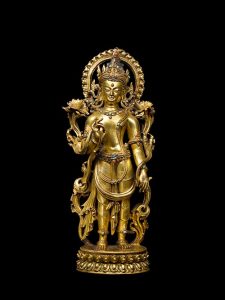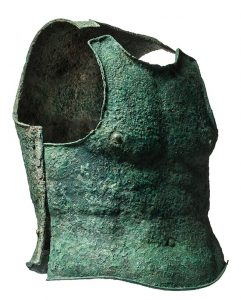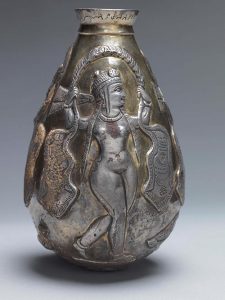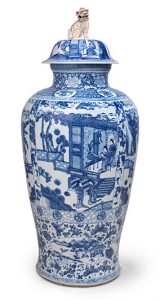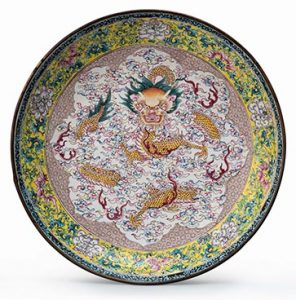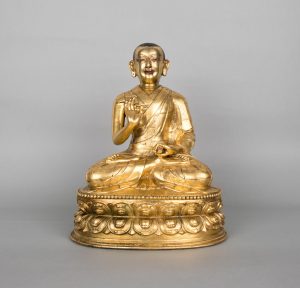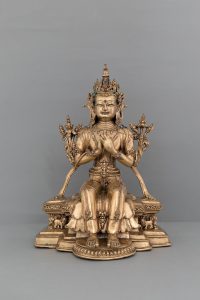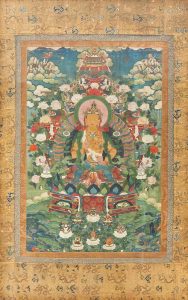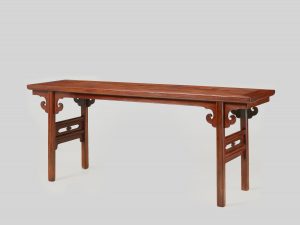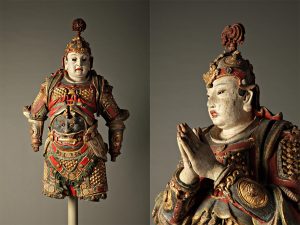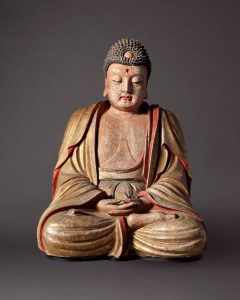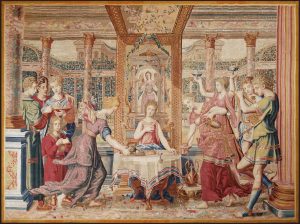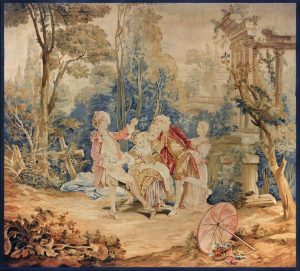Exceptional Museum-Quality Antiques at Fine Art Asia 2018
29 September – 2 October 2018, Hong Kong Convention and Exhibition Centre
Fine Art Asia 2018, Asia’s leading annual fine art fair, showcases the elite of antiques galleries worldwide. Expert specialists from both East and West will present an unprecedented range of museum-quality artworks, ranging from ancient Chinese and Himalayan bronzes to Central Asian gold wares, Chinese porcelain and lacquer to furniture, textiles and works of art.
Carlton Rochell spent the first 18 years of his career at Sotheby’s, where he founded the Indian and Southeast Asian Art Department in 1988. Later, he became the Managing Director of Sotheby’s China and Southeast Asia and Head of the Sotheby’s Asian Departments worldwide, as well as a highly regarded auctioneer. Since its founding in 2002, Carlton Rochell Asian Art has handled important works of art from renowned collections and has sold to well-known institutions in the field as well as to distinguished private collectors.
Carlton Rochell Asian Art, New York returns to Fine Art Asia 2018 with Buddhist masterworks from Tibet and Nepal including a standing Bodhisattva from Nepal or Tibet, dating from the 14th century. In this elegant and powerful sculpture, the youthful bodhisattva stands in light tribhanga on a double lotus pedestal with his right hand in vitarka mudra. Both hands hold lotus stems which grow out of the pedestal and unfold into splendid blossoms next to the deity’s shoulders. His head is framed by a flaming aureole, and he wears a crown inset with jewels and magnificent earrings and fluttering hair bands.
Another highlight is a thangka of Vairocana, from the Drigung Kagyu School in Nepal, also from the 14th century. This superbly-painted thangka depicts Vairocana, the ‘Great Illuminator,’ seated in the gesture of Supreme Wisdom and resting on a lotus throne with multi-coloured petals. Surrounded by a chorus of celestial beings, including myriad Buddhas and two standing Bodhisattvas, the deity is adorned with lavish accoutrements including crown, earrings, necklaces, armlets, anklets, and belt, and a lower garment of richly designed textiles. The throne is guarded by lions and elephants and surmounted by a five-arc rainbow.
David Aaron, London, originally founded in Isfahan, Iran in 1910, is widely recognised as one of oldest and the most pre-eminent galleries in the world for important and exquisite antiquities and ancient works of art. The scope of the collection includes Greek, Roman, Egyptian, Persian, Central Asian, Near Eastern, Islamic and Indian works of art.
Leading the exhibition this year is a Greek cuirass made of bronze dating from the 4th century BC. First appearing in Archaic Greece, cuirasses are a form or ancient armour that came to prominence during the 4th and 5th centuries BC throughout the ancient world. Normally made from sheets of bronze, they were designed to mimic an idealised male torso, stressing the importance of maintaining a good physique as crucial to be a successful warrior, highlighting the virtues of fitness, power and perseverance. They appear throughout Classical art, worn by generals, emperors and deities. Unadorned examples such as this were more commonly used for actual combat, while highly decorated examples were for reserved for public procession.
Several similar cuirasses from Greece can be found in the Metropolitan Museum of Art, New York and the British Museum. Suggestive of both Classical warfare and the need for armour in combat, they also speak of a tradition of sculptural form and idealized beauty, along with for the virtues of strength and power. This cuirass is a rare and fine example which would have a desire once graced the torso of a great warrior in antiquity, providing him with a sense of both pride and protection as it was worn into battle.
Also showcased is a silver gilt Gilded Sasanian silver jar from Central Asia, dating from the 5th to the 7th century AD. The Sasanian Empire was the last great civilisation of Iran before the rise of Islam, ruling from 224-651 AD. The Sasanian people went on to have great influence on later Islamic culture, as well as on Roman, Indian, Chinese and African art, and later European Medieval art.
This dazzling and delicate Sasanian gilded silver bottle exemplifies the fine metalworking coming from the workshops in Iran. Globular in form and resting on a round base, with tapered shoulders, concave neck and inscribed rim, its alluring almond shape is beautifully proportioned. The body of the vessel depicts three dancing nude female figures, who move evocatively around the bottle, holding fluttering mantles that stream in the air. Adorned with thick necklaces, elaborate headpieces, and long beaded tresses that flow to their hips, they cut a sensual and rhythmic figure.
Sasanian glided jars can be found in the collections of the State Hermitage Museum in St. Petersburg, The British Museum in London and the Miho Museum in Kyoto. Two fine and similar examples are in the Shelby White and Leon Levy Collection in the Metropolitan Museum of Art in New York. Precious materials, exquisite in detail and quality, the similarities between this bottle and those found in public collections, highlight this as a museum quality piece.
Jorge Welsh Works of Art, London/Lisbon specialises in Chinese porcelain with an emphasis on export porcelain. The gallery returns to Fine Art Asia 2018 with rare works of art including a porcelain vase decorated in underglaze cobalt blue dating from the Kangxi period (1662-1722) of the Qing Dynasty. Vases of this shape and size are generally referred to as ‘soldier’ or ‘dragoon’ vases. This name derives from an historic exchange between Augustus the Strong (1670-1733), Elector of Saxony, King of Poland and Lithuania who was an avid collector of Chinese porcelain and received 151 porcelain vessels from the ‘Soldier King’ Friedrich Wilhelm I (1688-1740), King of Prussia and Elector of Brandenburg, in 1717.
Vases of enormous dimensions were first made at great expense in the late Kangxi period as a result of impressive technical achievements by the potters at the kilns in Jingdezhen. As they were extremely difficult to make, they were the most costly Chinese porcelain exported to the West at this time. In Europe, these vases were used to decorate the doorways and rooms of a private house.
Although vases of this shape were only made for export, the decoration is Chinese in concept. Narrative themes included scenes from Chinese history, mythology, novels, dramas and poetry, and were influenced by contemporary political issues, such as the rise of the Manchu Qing dynasty after 1644. The scene depicted may illustrate an episode from one of the many novels popular among ladies of the nobility at the time. One of the most celebrated stories was the ‘Romance of the Western Chamber’.
Another highlight piece is a copper dish decorated with polychrome enamels from the Qianlong period (1736-1795) of the Qing Dynasty. Painted enamels were introduced to China by European merchants, diplomats and missionaries in the Kangxi period (1662-1722). Although a small number of these wares were produced in Beijing for the emperor, they are frequently referred to as ‘Canton’ enamel, after the main centre of production in China.
Drawing on a long tradition representing Chinese Imperial authority, the dragon depicted on the present dish would have been equally coveted by domestic and foreign clients. Akin to the four-clawed dragon (蟒 mang), which took a front-facing position when appearing as ceremonial state symbol on courtly robes, the animal on this dish is paired with several attributes conveying auspicious messages.
Dragons paired with bats became especially popular during the Qianlong period, as they took advantage of two puns: bats (蝠fu) for good fortune (福 fu) and dragons (龍 long) for prosperity (隆 long, the same character in the emperor’s name). In addition, dragons and phoenixes form a conjugal pairing popularly used as a wedding gift.
A slightly larger dish decorated with a similar composition to this one is in the British Museum, London. Further comparable dishes are in the State Hermitage Museum, St Petersburg and the Victoria and Albert Museum, London.
Extraordinary sculptures, bronzes and paintings from China, India, Mongolia, Nepal and Tibet are amongst the works of art on offer at Rossi & Rossi, London/Hong Kong, which has exhibited every year since the inception of the fair in 2006. Each piece displays masterful craftsmanship and embodies deep religious significance.
A highlight of the exhibition is a gilt bronze portrait of Dragpa Sherab (1310-1370), dating from c. 1370. He is seated in padmasana on a double-lotus base, with right hand in vitarka mudra, the gesture of teaching, at his chest and left hand resting in his lap holding a book, as a symbol of his enlightened wisdom and the transmission of knowledge. His serene expression is framed by short-cropped hair and flanked by pierced pendulous earlobes. He wears the patchwork robes of a monk, beautifully incised with intricate geometric and floral motifs. Dragpa Sherab served as the abbot of the famed Densatil Monastery from 1362 to his death in 1370. There is only one other known portrait of him, a 15th century woodblock print, making this portrait incredibly rare.
Also on offer is a finely cast early 15th century Tibetan gilt bronze sculpture of the bodhisattva Maitreya. The deity is depicted seated on an intricately cast lion throne with two legs pendant, his bare feet resting on a smaller lotus cushion. His hands are raised to his chest in dharmacakra mudra, symbolising the turning of the Wheel of the Law. The style of this sculpture – its elegant proportions, the smooth and skilful casting of the figure’s body and the treatment of the elaborate beaded jewellery – successfully demonstrates the excellent craftsmanship of 15th century Tibet.
Rossi & Rossi is also exhibiting an important group of Tibetan thangkas dating from the 17th to 19th century, with a catalogue by Himalayan scholar and curator Jeff Watt. Among them is an 18th century depiction of Vajrapani from China. Gold in colour, the deity is seated with hands in a relaxed gesture, while grasping the stems of two lotus flowers. He is identifiable by the presence of the vajra, his key attribute, which stands in the centre of the blossom to his right. He wears lavish jewellery and intricately patterned, multicoloured garments; a coloured halo and rainbow nimbus surround his body. At the top of the composition are clouds supporting heavenly musicians and offerings to the gods and goddesses. Delicately crafted and well preserved, the work is a fine example of the increasing popularity of Tibetan Buddhism in China during the 18th century.
Nicholas Grindley, UK has been dealing in and researching Chinese art for more than 35 years, with a particular interest in furniture and works of art. Exhibiting in London, New York and Hong Kong, he has placed works in leading museums and private collections worldwide.
A highlight of his exhibition at Fine Art Asia 2018 is a huanghuali inset leg table, pingtou’an, with cloud-shaped spandrels and high stretchers between the legs, dating from the late Ming Dynasty, 17th century. The Ming Dynasty is considered the golden age of classical Chinese furniture. Rare, high-quality Ming furniture has long been an important and refined collecting category and huanghuali is a highly desirable wood, sought after by collectors. Ming furniture in huanghuali was originally manufactured in Suzhou, in Jiangnan province, and was not only of superb quality but featured an ingenious and highly complex joinery system. This table would have graced a literati scholar’s studio and with its elegant style, perfect proportions, beautiful wood and meticulous craftsmanship, reflects perfectly his refined taste. It exemplifies the finesse of the best of classic Ming furniture.
Vanderven Oriental Art, The Netherlands, returning to Fine Art Asia for the 8th consecutive year, presents an important group of early Buddhist sculptures, dating from the early Ming Dynasty (1368-1644). Two temple guardians are fully dressed in armour, underlining their role as protectors of the Buddhist faith. One guardian has a fierce face and a combative pose, whilst the other has his hands held together in devotion and an expression of introspection.
Stucco was an effective way to produce such dramatic and large religious sculptures. The figures were constructed on a wooden frame, padded with reeds, then modelled with clay stucco. It was smoothly finished with a thin layer of gesso, which was sometimes incised with decorative patterns. Finally it was covered with paper, which was painted and gilded.A monumental figure of Buddha from Shanxi Province is seated in ‘padmasana’ lotus position with his hands in ‘dhyana’ mudra the gesture of absolute balance. He emits a sense of vastness and serenity in meditation. His robes are gilt, with a patterned design and a red lining. The flesh is painted in soft pinkish tones, and the tight curls on the head have traces of the original blue paint. The eyes are inlaid with black glass for dramatic effect.
A pair of large bodhisattvas are seated on lotus bases in the pose ‘Royal Ease’. One has his right hand raised in the vitarka mudra, representing intellectual argument and the wheel of law. The other holds a scroll, representing Buddhist teaching.
Luohans Ananda and Kasyapa are dressed as monks, with shaved heads and long flowing robes; their elongated earlobes indicating they are enlightened beings. The elder figure is Kasyapa; his hands are locked in the Kanjo-in mudra – bestowing Buddha’s great mercy. The younger monk is Ananda, his palms pressed together in the namaskara mudra – a gesture of greeting and prayer. The robes of both figures are covered with a fine fabric and remnants of dark lacquer. These two important luohans, are often depicted as a pair in attendance to the historical Shakyamuni Buddha.
Fine Art Asia is delighted to welcome Boccara Gallery, Paris/Brussels, specialists in antique, modern and contemporary tapestries, who will exhibit for the first time in Hong Kong. Founded in 1995 by Didier Marien, a member of CECOA (the European Chamber of Expert Advisers in Works of Art), Boccara Gallery presents exquisite monumental antique tapestries from the 17th to 19th century, as well as modern tapestries designed by renowned 20th century artists including Wassily Kandinsky, Sonia Delaunay and Alexander Calder.
Highlights of the exhibition include the spectacular Psyche’s Dinner in the Palace of Cupid, a tapestry made in the Ateliers du Faubourg Saint Germain, Paris, in c. 1660. In 1667 it became part of the collection of King Louis XIV of France and hung at the Palaces of Versailles and Fontainebleau during the 18th century. Having miraculously escaped the ravages of the French Revolution, the tapestry was sent to the Château de Pau in 1854.
The theme of this tapestry was inspired by Greek and Roman mythology: the thwarted love of the beautiful mortal Psyche and Cupid, the god of love. Here, Psyche is mysteriously brought to a marvellous palace by the wind god Zephyr and served at table by invisible servants (symbolised by small wings on their backs). The abundance of precious materials used, the balance of the composition, the variety and subtlety of the colours, all combine to make this tapestry a masterpiece.
Another outstanding exhibit at the fair is Garden Games, made by the Beauvais Royal Manufacture in the 18th century. In this tapestry, a group of young nobles and their servants are playing in a garden, with a fountain and chateau in the background. The flower basket and parasol in the foreground suggest the young girl was interrupted by the nobles when picking flowers. The whole scene is depicted in the romantic Rococo style. This tapestry was designed by François Boucher, perhaps the most celebrated painter and decorative artist of the 18th century. It is woven in 95% natural silk and in perfect original condition.
-End-

